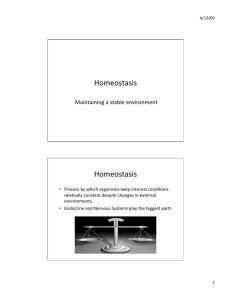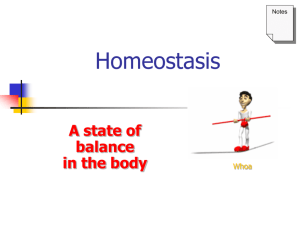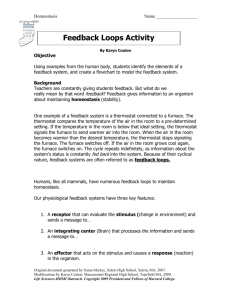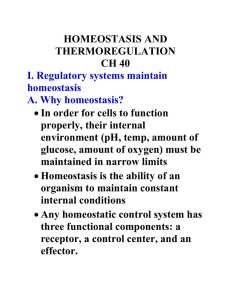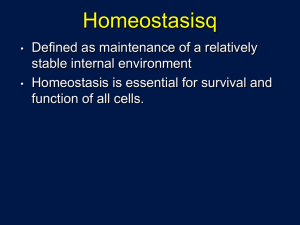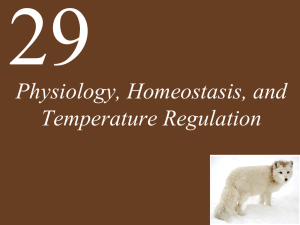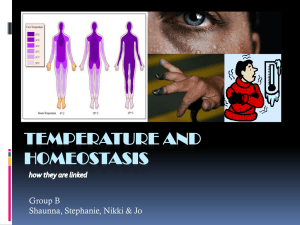Homeostasis _1_
advertisement
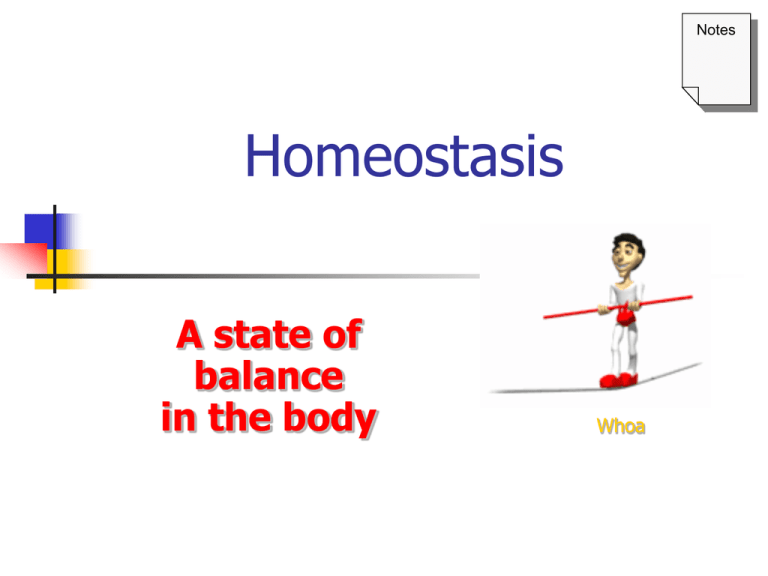
Notes Homeostasis A state of balance in the body Whoa Definition of Homeostasis homeo = same; stasis = standing Homeostasis is the term we use to describe the constant state of the internal environment. Homeostasis is a state of balance in the body. The processes and activities that help to maintain homeostasis are referred to as homeostatic mechanisms. Introduction You are exposed to ever changing environmental conditions. For example, you may walk out of an air conditioned room into the hot summer sun. However the cells in your body work best when their surroundings are kept constant. Your body has many mechanisms that keep the cells surroundings constant even though your external environment is changing. This is homeostasis. Homeostasis is very important because when it fails you become ill and may die. Maintaining Homeostasis Chemistry is the reason why we must maintain homeostasis. Biochemical processes (the chemical reactions) that occur within us) are vital to life and occur efficiently only within a limited temperature range and at a specific pH. Internal Communication The body must have good internal communication, using the endocrine and nervous systems, to maintain homeostasis. Feedback inhibition limits the operation of a system or causes it to shut down when it senses too much of a certain product (such as water, glucose, salt, heat, CO2 etc.) It will cause the system to “turn back on” when there is too little of this product. A Temperature Control System To help us understand homeostasis in living organisms, let us first look at a non-living system. We will use a temperature control system for a room which has many similar features to homeostatic mechanisms…. Click on the thermostat. Human Body Temperature Control You have just studied how the temperature of a room can be controlled. Now you will examine how similar mechanisms operate to control body temperature in humans. Go to this web address…. Click on the hot man. A Review Example: thermostatic heating system in a home Components of an automatic control system Variable is the characteristic of the internal environment that is controlled by this mechanism (internal temp in this example). Sensor (receptor) detects changes in variable and feeds that information back to the integrator (control center) (thermometer in this example). Example Continued Integrator (control center) integrates (puts together) data from sensor and stored "setpoint" data (thermostat in this example). Set point is the "ideal" or "normal" value of the variable that is previously "set" or "stored" in memory. Effector is the mechanism (furnace in this example) that has an "effect" on the variable (internal temperature in this example). Summary Changes in temp are detected by thermometer, which feeds info about the actual temp back to thermostat. Thermostat has been previously set to ideal (set point) value; thermostat compares actual value to set point value and sends signal to furnace. Furnace fires up and changes the internal temp back toward set point. (Furnace will shut down when thermostat determines actual temp is now higher than set point temp). Negative Feedback Negative feedback Occurs when feedback (from sensor to integrator) results in a reversal of the direction of change. An example: thermostat's response causes temperature decrease to reverse and become a temperature increase. Negative feedback tends to stabilize a system, correcting deviations from the set point. Human Example of Negative Feedback Human example: shivering in response to cooling of body during cold weather or sweating when their core temperature gets too hot. Homeostasis allows an organism to remain in balance with its environment. If homeostasis is not maintained, it can harm or kill the organism. Hire-wire Artist Model Variable: position of body Setpoint: directly over the wire Sensors: nerve receptors (eyes, inner ears, muscle stretch receptors, etc.) Integrator: brain Effectors: skeletal muscles High-wire artist uses negative feedback to maintain relatively constant position on wire.
